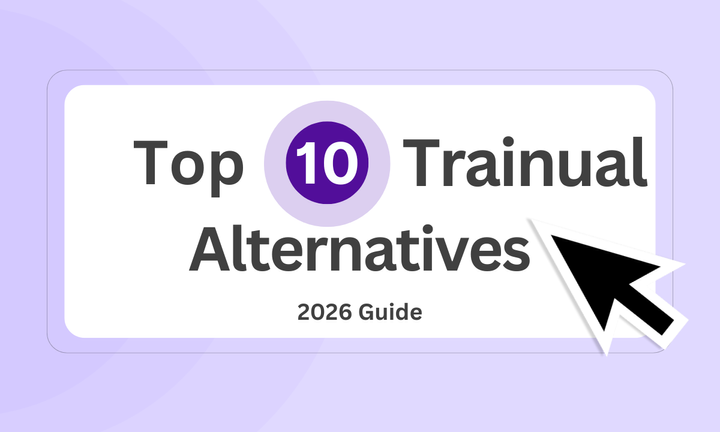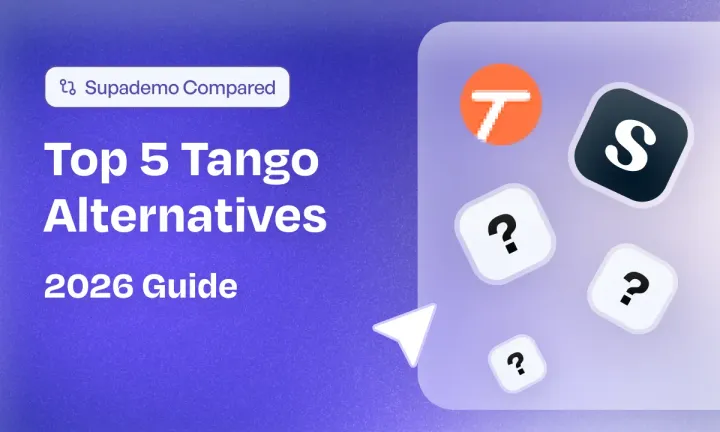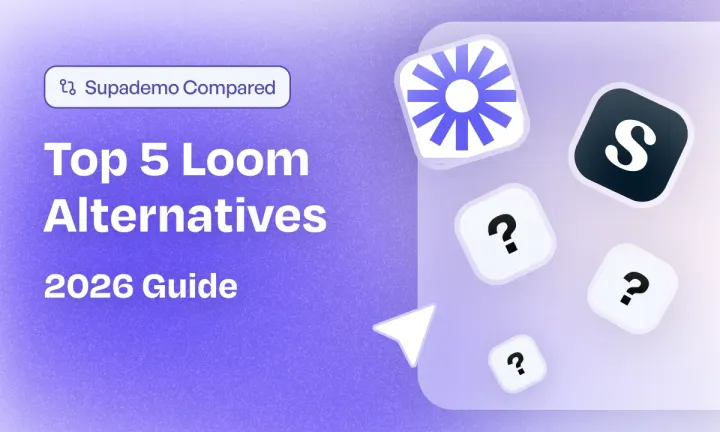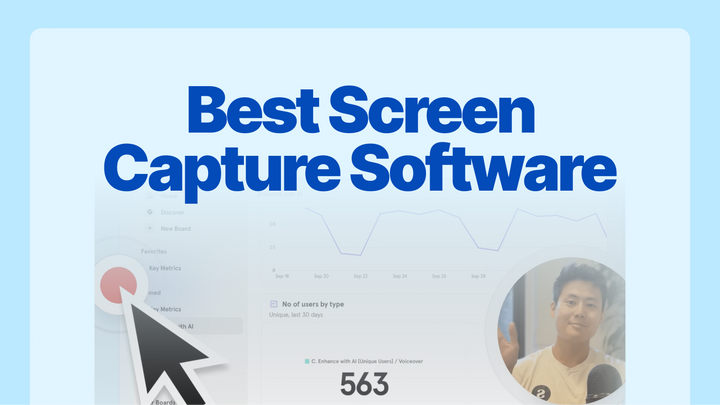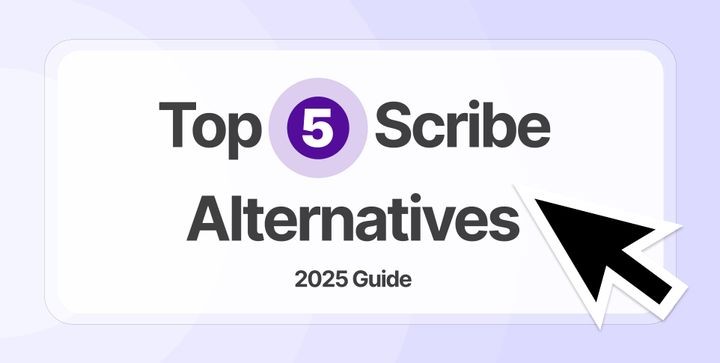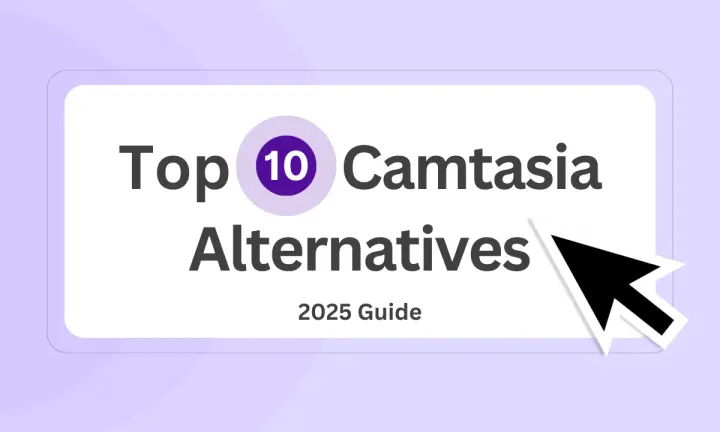Picture baking a cake without a recipe—eyeballing flour, forgetting baking powder, and ending up with a sad pancake. That’s business without documented processes: chaos, confusion, and constant ‘Where’s that info?’ cries. Trainual aims to fix that, streamlining workflows, onboarding, and consistency.
But in 2026, its clunky formatting, missing flowcharts, and paywall traps push users to better Trainual alternatives. Whether you need richer visuals, simpler pricing, or smarter automation, you’re in the right place. Let’s explore the top Trainual alternatives & competitors for 2026—tools built to work for you, not against you.
TL;DR
Whale: Ideal for companies needing structured knowledge management, process documentation, and AI-powered content creation.
Scribe: Great for teams that want to automate step-by-step process documentation with AI-generated text and screenshots.
Tango: Best for teams that need automated workflow recording, easy customization, and seamless integration with knowledge bases.
iorad: Perfect for businesses looking to create step-by-step interactive tutorials with voiceovers, translations, and multiple export formats.
TalentLMS: Best for structured courses, compliance training, and certification programs with built-in AI tools for content and translation.
Guru: Best for capturing and sharing company knowledge with AI-powered search and contextual insights inside Slack and Teams.
360Learning: Best for collaborative course creation and social learning where employees co-create and review training content.
Docebo: Best for enterprise-grade LMS needs with AI personalization, compliance tracking, and large-scale training delivery.
Guidde: Best for creating AI-generated training videos with voiceovers, captions, and branded visual walkthroughs in minutes.
What is Trainual?
Trainual is a process documentation and employee training platform designed to help businesses create, organize, and share standard operating procedures (SOPs), company policies, and training materials in one centralized system. It acts as a digital playbook, allowing teams to document workflows, streamline onboarding, and ensure consistency across operations.
Why do customers look for Trainual alternatives? (with proof)
While Trainual is widely used for process documentation and employee training, some users find limitations that prompt them to explore alternatives. Based on authentic user reviews, here are the key reasons businesses seek a different solution.
1. Lack of flowchart support for visual learners
Trainual allows users to document processes with text, images, and videos, but some users find it lacking in visual structuring tools.

For teams that rely on flowcharts to simplify complex workflows, Trainual's text-based approach can feel limiting. Users looking for a more visually intuitive tool may consider alternatives with built-in flowcharting and diagramming features.
2. Content organization can be tricky for large teams
For small teams, Trainual’s structured approach works well, but as organizations scale, managing content becomes more complex.

Another user echoed similar frustrations:

Without robust content segmentation and discoverability features, companies managing multiple teams and departments may struggle to keep their documentation streamlined.
3. Formatting options can feel restrictive
While Trainual simplifies documentation, some users feel constrained by its formatting tools.

Similarly, another user noted:

For businesses that require highly customized documentation layouts, Trainual’s rigid formatting may not provide enough flexibility.
4. The video recording feature is not included in all plans
Trainual offers video recording functionality, but not all users are aware that it requires an upgraded subscription.

For teams that heavily rely on video-based training, this limitation could lead them to seek alternatives that include recording and editing tools in their base plans.
5. Performance issues and slow loading times
While Trainual is designed to be an efficient training platform, some users report slow performance.

Another user encountered delays when exporting content, stating:

For teams that need fast-loading, high-performance software, these minor delays can become a significant productivity blocker.
What are the best alternatives to Trainual in 2026?
| Trainual Alternative | Best For | G2 Rating |
|---|---|---|
| Supademo | Creating interactive, AI-powered demos with analytics for onboarding, training, and SOPs | 4.7 |
| Whale | Structured knowledge management, process documentation, and AI-assisted content creation | 4.7 |
| Scribe | Automating step-by-step documentation with AI-generated text and screenshots | 4.8 |
| Tango | Automatic workflow recording, customization, and integration with internal knowledge bases | 4.8 |
| iorad | Creating interactive tutorials with AI voiceovers, translations, and multi-format exports | 4.8 |
| TalentLMS | Structured courses, compliance training, and certification programs with AI content tools | 4.6 |
| Guru | AI-powered knowledge base for capturing and sharing company knowledge within workflows | 4.7 |
| 360Learning | Collaborative course creation, social learning, and peer-driven corporate training | 4.6 |
| Docebo | Enterprise LMS with AI-driven personalization, analytics, and large-scale compliance tracking | 4.7 |
| Guidde | AI-generated training videos with captions, voiceovers, and branded step-by-step walkthroughs | 4.8 |
1. Supademo
Supademo is an interactive demo creation platform designed to help teams build, share, and track product walkthroughs without coding. It enables businesses to create step-by-step guided experiences that showcase software features, streamline onboarding, and drive product adoption. Unlike static PDFs or lengthy training videos, Supademo provides click-through interactive demos that feel like real product interactions.
What are Supademo’s key features?

1. Interactive, no-code demo creation
Supademo simplifies the process of creating interactive demos without requiring any technical expertise. Unlike traditional screen recordings, Supademo captures workflows step by step, allowing users to build engaging, click-through experiences that capture the fidelity of a software product.
This makes it an ideal solution for creating interactive guides, tutorials, and walkthroughs for Trainual's common use cases: employee onboarding, training, and SOPs.
With its intuitive, no-code editor, users can customize each demo step using annotations, tooltips, and guided prompts. Supademo also allows for dynamic editing—you can reorder steps, zoom into key actions, and blur sensitive data without re-recording. This flexibility ensures that demos remain polished, professional, and always up to date.
2. AI-powered automation
Supademo uses AI to automate time-consuming demo creation tasks, helping teams work faster and more efficiently. The AI-generated text annotations automatically create clear, benefit-driven descriptions for each step, eliminating the need for manual copywriting.
You can use synthetic AI voiceovers or clone your voice to create a more personalized training guide, making demos more accessible to a global audience.
The platform also supports instant translations, allowing businesses to localize their interactive content in seconds. With these AI-driven features, teams can focus on storytelling and engagement while Supademo handles the heavy lifting.
3. Showcases for organized demo sharing
Supademo’s Showcases feature allows users to bundle multiple interactive demos into a single, structured presentation. This is particularly useful for onboarding flows, tutorials, and training, where a sequential learning experience enhances understanding.
Showcases are fully customizable, enabling teams to arrange demos in chapters, add descriptions, and include CTAs for the next steps. The feature also integrates seamlessly with websites, knowledge bases, and training portals, making it easy to embed interactive walkthroughs in relevant touchpoints.

This structured approach enhances user engagement and ensures that critical information is always accessible.
4. Custom branding and personalization
Supademo provides extensive branding and customization options, allowing businesses to maintain a cohesive brand identity across all interactive demos.
Users can add their company’s logo, customize color schemes, and incorporate brand-specific messaging into tooltips and callouts. This ensures that every demo aligns with the company’s visual identity and maintains a professional appearance.
Additionally, Supademo supports dynamic variables, enabling teams to personalize demos with user-specific data, such as names, account details, or company-specific terminology. This level of customization helps create a more immersive experience for viewers, increasing engagement and reinforcing the relevance of the content.
5. In-app demo hub
Supademo offers In-app demo hubs, which are a searchable library of interactive, step-by-step demos embedded inside your internal tools, delivering just-in-time training.
Employees learn workflows in context, ramp up faster, reduce mistakes, and minimize support requests.
6. HTML-powered interactive demos
Supademo goes beyond traditional video-based walkthroughs by offering HTML-based interactive demos. This approach captures the actual HTML & CSS elements of a website or web app, allowing users to interact with the demo as if they were using the real application.
Unlike static recordings, Supademo preserves hover effects, dropdown menus, and transitions, making the experience far more engaging.
Because Supademo demos are built using HTML and CSS rather than video files, they are lightweight and load quickly across different devices. Additionally, users can update text, numbers, and placeholder data without re-recording the entire demo. This ensures that product demos remain current and relevant, even as product interfaces evolve.
What is Supademo’s pricing?
Pro Plan ($36/user/month): Expands on the Free Plan with unlimited Supademos, a collaborative team workspace, zoom and autoplay features, custom branding, annotation and blur tools, demo analytics, and access to Supademo AI.
Scale Plan ($50/user/month): Adds dynamic variables, trackable sharing links, conditional branching, password and email protection, custom domain options, advanced viewer insights, collaborative commenting, and third-party integrations.
Growth Plan ($450/user/month): Includes everything in the Scale Plan with 5 creators pre-bundled, unlimited view-only team members, unlimited HTML interactive demos, the ability to edit text, images, and HTML elements, and invisible hotspots.
Enterprise Plan (Custom Pricing): Offers all Scale Plan features, plus HTML capture, Single Sign-On (SSO) and SAML authentication, multiple workspaces, analytics export capabilities, custom data retention settings, dedicated support, and white-glove onboarding.
What are Supademo’s pros & cons?
✅ Showcases enable users to structure and share multiple demos in an organized format.
✅ Responsive customer support actively listens to user feedback and continuously enhances the platform.
✅ Auto-navigation and hotspots enhance interactivity, making demos more engaging.
✅ Budget-friendly alternative compared to expensive SaaS demo creation tools.
❌ Slide rearrangement can feel unintuitive at times.
❌ Doesn't allow you to see training progress per employee.
Why should you choose Supademo over Trainual?
Here's a Supademo vs. Trainual comparison table:
| Feature | Supademo | Trainual |
|---|---|---|
| Best for | Sales, Customer Success, Marketing, GTM Teams | HR, Operations, Training & Onboarding Teams |
| Pricing | Starts at $27/mo | Starts at $49/mo |
| Ease of use | ⭐ 9.3 (Highly rated for usability) | ⭐ 8.0 (More structured setup) |
| Demo creation type | Screenshot-based, Interactive Walkthroughs, Video Uploads | Step-by-step Training Documentation & Video Tutorials |
| Customization | ✅ Full branding, UI customization | ✅ Branding available, but limited layout options |
| No-code editing | ✅ Yes, fully no-code | ✅ Yes (Drag-and-drop editor) |
| Demo showcases | ✅ Yes (Bundle multiple demos in one) | ⛔ No (Separate training modules only) |
| In-app demo hub | ✅ Yes (Searchable in-app library embedded in product) | ⛔ No (No embedded interactive demo hub) |
| Real-time personalization | ✅ Yes | ⛔ No (Standardized training templates) |
| AI voiceovers | ✅ Yes (Multi-language support) | ⛔ No (Requires manual narration) |
| Embed content anywhere | ✅ Yes (Web, App, Email, Docs) | ✅ Yes (Limited embedding options) |
| Team enablement | ✅ Yes (Prebuilt demo assets for sales & CS teams) | ✅ Yes (Onboarding and SOPs for HR & Ops) |
| Integrations | ✅ HubSpot, Salesforce, Zapier, GA4 | ✅ Slack, Zapier, BambooHR, QuickBooks |
| Advanced analytics | ✅ Yes (User engagement insights) | ✅ Yes (Training progress tracking, reports) |
| Free plan | ✅ Yes | ⛔ No (14-day trial available) |
When it comes to creating interactive demos and training materials, both Supademo and Trainual offer valuable features. However, Supademo stands out as the better choice for teams that need flexibility, ease of use, and cost-effectiveness.
With its fully no-code editor, AI voiceovers, and seamless demo embedding options, Supademo makes it easy to create and share engaging walkthroughs without the structured limitations of traditional training tools.
Whether you're in HR & operations (or marketing, customer success, and sales), Supademo provides a more scalable and user-friendly experience without the overhead of complex training management systems.
Why is Supademo is a better alternative to Trainual?
1. No formatting restrictions or hidden paywalls
One of the biggest frustrations with Trainual is its restrictive formatting options. Trainual lacks a simple copy-paste feature and forces preset font and size conditions, making content creation unnecessarily time-consuming.
With Supademo, customization is effortless. Users can freely edit steps, rearrange sequences, and apply annotations without rigid formatting constraints. Plus, Supademo’s pricing model ensures that even free users can create interactive demos with AI-powered voiceovers, branding, and analytics—without hitting unexpected paywalls.
2. More intuitive and efficient demo creation
Trainual users often face a learning curve when trying to organize content effectively. Many report challenges in setting up structured training paths, filtering content for specific teams, or even finding relevant materials quickly. For new users inheriting the platform, the lack of a guided walkthrough can make onboarding difficult.
Supademo eliminates these hurdles with an intuitive, no-code editor that allows users to create guided, interactive demos in minutes. AI-powered automation handles annotations and voiceovers, while the Showcase feature allows businesses to structure multiple demos into a seamless, easy-to-navigate flow.
This makes it simple to deliver engaging, step-by-step training experiences—without the hassle of complex content management.

3. Faster performance and seamless access
A common complaint among Trainual users is slow loading speeds, even with strong internet connections. When teams rely on a tool for daily training and onboarding, delays in accessing content can disrupt workflows and reduce efficiency.
Additionally, some users report difficulties in downloading complete training materials, with PDFs failing to generate correctly.
Supademo ensures a frictionless experience by delivering lightweight, HTML-powered interactive demos that load instantly—no waiting, no glitches.
You can embed demos directly into knowledge bases, onboarding flows, internal collaboration platforms, or help centers, ensuring that your interactive content is always accessible. Plus, with built-in analytics, teams can track engagement and refine their demos in real time.
2. Whale
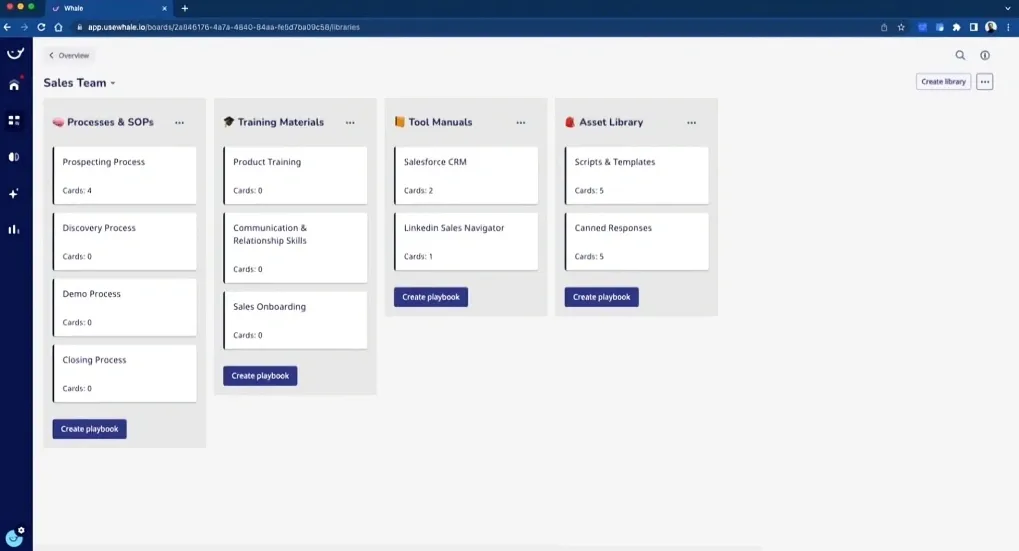
Whale is a knowledge management and training platform designed to help teams centralize, structure, and share company knowledge effortlessly.
Whale enables businesses to document processes, onboard employees, and ensure continuous learning through interactive playbooks and AI-powered content creation. By integrating with everyday work tools like Slack and Microsoft, Whale ensures knowledge is accessible when and where teams need it.
What are Whale’s key features?
- AI-powered content creation: Whale automates documentation by generating training materials from existing resources, making content creation quicker and less manual.
- Playbooks for process documentation: You can organize knowledge into structured playbooks, ensuring teams can easily access and follow standardized procedures.
- Interactive training modules: Unlike static documentation, Whale enables teams to create interactive lessons with quizzes, multimedia, and engagement tracking.
- Automated knowledge updates: Content doesn’t become outdated, as Whale reminds owners to review and update materials periodically.
What is Whale’s pricing?
Scale ($149/15 users included/month): Access to everything from the Free plan and QR codes, AI quizzes, Training flows, Contextual suggestions, badges, Auto translate and more.
Enterprise (Custom pricing): Everything from the Scale plan and SCIM, HRIS Integrations, API access for custom integrations, 1 click export and more.
What are Whale’s pros & cons?
✅ AI-powered search helps employees quickly find critical information.
✅ Implementation is easy, with dedicated customer support ensuring a hassle-free experience.
✅ User-friendly interface and templates streamline company-wide process management.
❌ Lack of personalization features.
❌ The content editor has limited formatting options for text and spacing adjustments.
❌ Understanding the difference between cards and playbooks may require a learning curve.

Whale vs Trainual
| Feature | Whale | Trainual |
|---|---|---|
| Best for | AI-assisted SOPs, playbooks, and just-in-time answers | SOPs, policies, structured onboarding playbooks |
| Pricing | Free plan; Scale user-based; Enterprise (quote) | From $249/mo for 10 seats (annual) |
| Setup & ease of use | Fast rollout; intuitive UI and browser tools | Straightforward SOP builder and assignments |
| Knowledge capture | Playbooks/Cards with AI assist & step recorder | Subjects, topics, policies, tests |
| Training workflows | Role-based flows with assignments & reminders | Assignments and due dates in playbooks |
| Quizzes & assessments | ✅ AI-generated quizzes; assign to users/groups | ✅ Quizzes and tests (manual authoring) |
| Auto-translate / localization | ✅ Auto-translate at card level (multi-language) | Limited; no native auto-translate feature advertised |
| Browser extension | ✅ Chrome/Edge extensions (CoPilot, CoCreator) | ⛔ No dedicated capture/answer extension |
| Slack integration / in-workflow surfacing | ✅ Slack integration for notifications & suggestions | ✅ Slack integration; content accessed in Trainual app |
| SOP & policy hub | ✅ Playbooks with versioning and reviews | ✅ Structured SOP/policy playbooks with roles/groups |
| Courses / SCORM / xAPI | ⛔ Not an LMS; no SCORM/xAPI | ⛔ Not supported (not SCORM/xAPI compliant) |
| Reporting & analytics | Usage, assignments, quiz results, review cycles | Training progress, assignments, usage reports |
| Free plan / trial | ✅ Free plan; Scale & Enterprise tiers | ✅ Free trial; paid plans from $249/mo (10 seats) |
3. Scribe

Scribe is a documentation tool designed to simplify the process of creating step-by-step guides. It automatically captures workflows, generates instructions, and formats them into shareable guides—making it an ideal solution for teams looking to document processes, onboard employees, or provide customer support without the hassle of manual documentation.
What are Scribe’s key features?
- Automatic step-by-step capture: Perform a task once, and Scribe records each step, generating a complete guide with screenshots and written instructions.
- AI-powered text generation: Enhances clarity by auto-writing explanations, saving users from crafting descriptions manually.
- Screenshot editing & redaction: Users can blur sensitive information to maintain privacy while keeping documentation visually clear.
- Organized documentation management: Guides are stored in structured workspaces with customizable permissions to control access.
What is Scribe’s pricing?
Scribe's pricing is tailored for different types of teams and it's divided into four tiers:
Pro Personal ($29/seat/month): Ideal for individual users, providing desktop app access, branding customization, and export options.
Pro Team ($15/seat/month): Designed for teams, featuring collaboration tools for streamlined group documentation.
Enterprise (Custom pricing): Tailored for organizations requiring advanced security, SSO authentication, automated data redaction, and centralized control.
What are Scribe's pros & cons?
✅ Creates polished, professional documentation without the need for design expertise or templates.
✅ Allows quick guide updates by re-recording steps, eliminating the need for manual revisions.
✅ Compatible with both web and desktop applications, ensuring broad documentation coverage.
❌ Provides limited formatting options compared to specialized documentation tools for text-heavy content.
❌ May not always accurately capture complex UI interactions, sometimes requiring manual adjustments.
❌ Managing lengthy processes can be challenging without manually organizing them into sections.

Scribe vs Trainual
| Feature | Scribe | Trainual |
|---|---|---|
| Best for | Instant step-by-step guides with AI | SOPs, policies, onboarding playbooks |
| Pricing | Personal $23/user/mo; Team $59/mo incl. 5 users (+$12 per extra) | From $249/mo for 10 seats (annual) |
| Setup & ease of use | Capture a workflow and auto-generate a guide | Straightforward SOP builder and assignments |
| Capture type | Step recorder creates screenshots + text | Text, image, and video lessons in playbooks |
| AI features | AI-generated steps, text, and quick guides | AI assists for documenting SOPs and templates |
| Browser extension | ✅ Chrome extension for capture and share | ⛔ No dedicated capture extension |
| Exports & embeds | Embed or export to KBs like Notion/Confluence, PDF | Share training in app; basic embeds/links |
| SOP / policy hub | Guides and pages; not a full SOP wiki | ✅ Structured SOP/policy playbooks with roles/groups |
| Courses, quizzes, certifications | ⛔ Not an LMS; no courses | Quizzes/tests; not a full LMS |
| SCORM/xAPI support | ⛔ Not supported | ⛔ Not supported |
| Integrations | Notion, Confluence, SharePoint, Teams, more | Slack, Zapier, BambooHR, QuickBooks, SSO |
| Reporting & analytics | Views and usage; depends on plan | Training progress and assignment tracking |
| Free plan / trial | Free plan; Team starts at 5 seats | Free trial available |
4. Tango
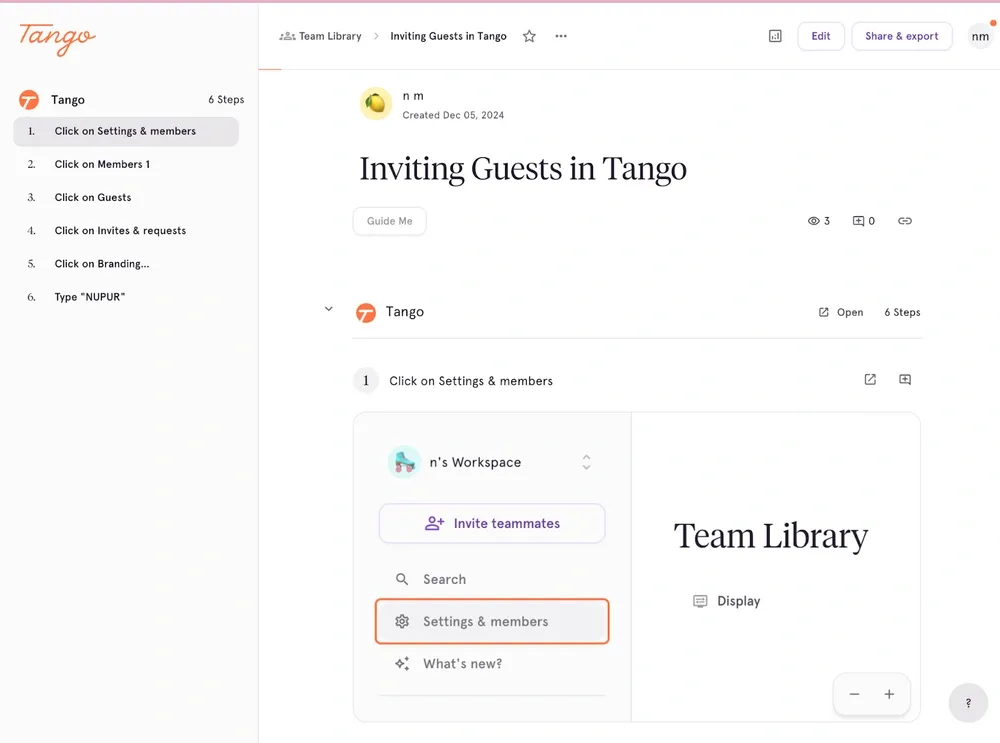
Tango is a process documentation tool that simplifies the creation of step-by-step guides and tutorials with minimal effort. Whether you need to build SOPs, training materials, or user guides, Tango streamlines the process by automatically capturing actions as users complete tasks.
This removes the need for manual screenshots, formatting, and descriptions, making documentation quick and efficient.
What are Tango's key features?
- Automated workflow recording: Tango’s Chrome extension automatically captures workflows in real-time as users navigate software applications, reducing the effort required to document processes.
- Built-in editing and customization: Users can refine captured steps by editing, rearranging, and adding titles, descriptions, annotations, or callouts. AI-powered blurring tools help protect sensitive information, ensuring compliance with security and privacy policies.
- Seamless integration with knowledge bases & LMS: Tango-generated guides can be embedded directly into platforms like Notion, Confluence, SharePoint, and Slack, making training materials easily accessible within existing workflows.
What is Tango's pricing?
Tango's pricing has three tiers:
Pro ($20/month per seat): Includes unlimited workflows, browser and desktop capture, branded exports, and advanced viewership insights.
Enterprise (Custom pricing): Designed for large organizations, offering SSO, SCIM, advanced workspace roles, on-screen walkthroughs, automatic PII blurring, and an admin analytics dashboard.
What are Tango's pros & cons?
✅ Automatically blurs sensitive data for privacy protection.
✅ Guides can be saved as PDFs for easy distribution.
✅ Users can modify, rearrange, and enhance automatically generated steps.
❌ The app's launch process isn't as smooth as expected.
❌ Does not capture browser tabs, limiting workflow demonstrations.
❌ Users cannot attach additional documents to a workflow.

Tango vs Trainual
| Feature | Tango | Trainual |
|---|---|---|
| Best for | Instant step-by-step guides & process capture | SOPs, policies, onboarding playbooks |
| Pricing | Free; Pro from ~$22/user/mo (annual) or ~$26 (monthly) | From $249/mo for 10 seats (annual) |
| Setup & ease of use | Chrome extension + desktop app; capture to guide in minutes | Straightforward SOP builder with roles/assignments |
| Capture type | Auto step capture (screenshots + text) in browser & desktop apps | Text/image/video lessons; no auto step-capture recorder |
| PII blurring | Batch Blur; Secure Blur (auto PII) on Enterprise | Manual media handling; no native auto-PII blur |
| Exports & embeds | Export to PDF; embed in Notion/Confluence & more; share links | Share inside Trainual; basic embeds/links |
| SOP / policy hub | Great for visual “how-to” guides; not a full SOP wiki | ✅ Structured SOP/policy playbooks with groups/roles |
| Courses, quizzes, certifications | ⛔ Not an LMS; no courses/certifications | Quizzes/tests; not a full LMS |
| SCORM/xAPI support | ⛔ Not supported | ⛔ Not supported |
| Reporting & analytics | Viewership insights (Pro+); workspace usage | Training progress, assignments, usage reports |
| Free plan / trial | ✅ Free plan; Pro & Enterprise available | ✅ Free trial; paid plans start at $249/mo |
5. iorad
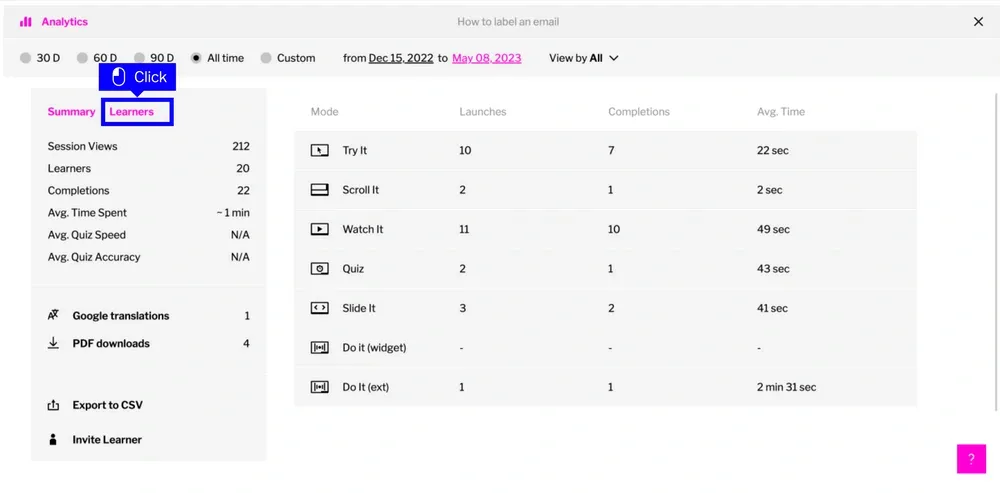
iorad is a step-by-step tutorial creation tool designed to help businesses and educators document processes quickly and efficiently. It automatically captures actions performed on a screen—such as clicks, typing, and navigation—and converts them into interactive, guided tutorials.
Unlike traditional documentation methods that require manual screenshots and text descriptions, Iorad streamlines the process by recording user actions in real time and generating structured walkthroughs with text, images, and even AI-powered voiceovers.
What are iorad’s key features?
- Automatic step-by-step recording: Perform actions like clicking, typing, and navigating, and Iorad will instantly create a structured tutorial, breaking each action into individual steps.
- Multiple output formats: Convert tutorials into different formats, including interactive walkthroughs, PDFs, narrated videos, or embeddable knowledge base articles.
- AI-generated voiceovers and translations: Iorad offers AI-powered voice narration and multilingual support, making it simple to scale training for global teams.
- Quick sharing and embedding: Tutorials can be instantly shared via a direct link or seamlessly embedded into platforms like Notion, Confluence, or an LMS.
What is iorad’s pricing?
iorad's pricing is expensive as compared to other options available. It is divided into 3 tiers:
Team Plan ($500/month): Offers everything in the Individual plan, plus premium audio, video recording, custom branding, export options, step lists, analytics, auto-domain sharing, team collaboration, single sign-on (SSO), Salesforce integration, external content embedding, automation tools, AI-powered writing, and a mobile version.
Enterprise Plan (Custom Pricing): Includes all features from the Team plan, along with translations, multiple team accounts, advanced export options, encryption, and anti-tracking features.
Iorad’s pricing tends to be higher compared to other similar tools.
What are iorad’s pros & cons?
✅ Users can modify steps after recording, allowing for easy and flexible adjustments.
✅ Masking tools safeguard sensitive data while keeping tutorials interactive.
✅ The Chrome extension simplifies tutorial creation with a user-friendly interface.
❌ The tutorial flow may need manual tweaks for better readability.
❌ Occasional glitches on some web pages can result in incomplete recordings.
❌ Pricing may be high for smaller teams or individual users.

iorad vs Trainual
| Feature | iorad | Trainual |
|---|---|---|
| Best for | Step-by-step interactive tutorials & micro-training | SOPs, policies, onboarding playbooks |
| Pricing | Individual $200/mo; Team $500/mo; Enterprise custom | From $249/mo for 10 seats (annual) |
| Setup & ease of use | Browser extension; capture → auto tutorial in minutes | Straightforward SOP builder with roles/assignments |
| Capture type | Records clicks/typing/navigation into guided steps | Text/image/video lessons (no auto step capture) |
| AI voiceovers & translations | ✅ TTS voiceovers + translate module (multi-language) | Limited; no native multi-language TTS module |
| Browser extension | ✅ Chrome/Firefox/Edge extensions | ⛔ No dedicated capture extension |
| Exports & embeds | Interactive embeds, video/PDF exports, HTML packages | Share and embed content within Trainual; basic links |
| SCORM export (LMS) | ✅ SCORM 1.2 export available (Advanced Exports) | ⛔ Not SCORM/xAPI compliant |
| SOP / policy hub | Video/interactive tutorials; not a full SOP wiki | ✅ Structured SOP/policy playbooks with roles/groups |
| Courses, quizzes, certifications | ⛔ Not an LMS (no courses/certifications) | Quizzes/tests; not a full LMS |
| Integrations | Publish to KBs & tools; Salesforce/Slack (plans vary) | Slack, Zapier, BambooHR, QuickBooks, SSO |
| Reporting & analytics | Views & interaction analytics (Team+) | Training progress and assignment tracking |
| Free plan / trial | ✅ Free (public tutorials); paid plans available | ✅ Free trial available |
6. Talent LMS
TalentLMS is a cloud-based learning management system (LMS) designed to simplify corporate training, compliance, and employee development. It supports SCORM, xAPI, and cmi5, allowing teams to create structured courses, assessments, and certifications with full tracking.
What are TalentLMS’s key features?
- Standards compliance: Create, upload, and deliver SCORM, xAPI, and cmi5 courses with analytics and tracking.
- Learning paths and certifications: Group related courses into guided paths, set prerequisites, and issue certificates with expiration dates.
- Multi-portal branches: Create separate training environments with unique branding, languages, and permissions for different teams or clients.
- AI-powered tools: Automatically generate course content, quizzes, translations, and captions to speed up training creation.
What is TalentLMS’s pricing?
Core: From $119/month (annual) — includes 1 branch, custom domain, and SSO.
Grow: From $229/month (annual) — adds 3 branches and extended AI tools.
Pro: From $449/month (annual) — includes up to 15 branches, advanced analytics, and permissions.
Enterprise: Custom pricing for large organizations and additional features
What are TalentLMS’s pros & cons?
✅ Users consistently praise TalentLMS for its modern design, intuitive navigation, and ease of managing courses, uploads, and tracking progress.
✅ Implementation is smooth, with responsive customer support and helpful onboarding managers who guide teams through setup and customization.
✅ Supports multiple formats (video, PDF, SCORM, links) and offers AI-assisted authoring, translation, and reporting that streamline course creation and analysis.
❌ Users note limited customization in analytics and difficulty generating reports for grouped courses or detailed metrics.
❌ Image links can break when duplicating courses, and some AI-generated translations need refinement for industry-specific content.
❌ Elements like branch management and certain admin workflows feel less seamless compared to the rest of the platform.

TalentLMS vs Trainual
| Feature | TalentLMS | Trainual |
|---|---|---|
| Best for | Structured courses, certifications, compliance | SOPs, policies, onboarding playbooks |
| Pricing | Free plan; paid from ~$119/mo (Core) | Starts at ~$49/mo |
| Setup and ease of use | Fast rollout; clean admin UX | Straightforward SOP builder |
| Course authoring | Built-in builder, media modules, imports | Lessons, topics, tests for SOPs |
| Learning paths and certifications | ✅ Paths, certificates, expirations | Limited certificates and quizzes |
| SCORM/xAPI support | ✅ Yes (SCORM, xAPI) | ⛔ No SCORM/xAPI |
| Assessments and quizzes | Quizzes, assignments, surveys, banks | Quizzes and tests |
| Compliance tracking | ✅ Due dates, completions, audit trails | Completions and basic reports |
| Branches / multi-portal | ✅ Yes (multi-tenant branches) | Limited to roles and groups |
| SOP and policy documentation | Basic pages; not a full wiki | ✅ Strong SOP and policy hub |
| Knowledge base / wiki | ⛔ No native wiki | ✅ Yes (structured playbooks) |
| Integrations | SSO, HRIS, Zapier, Slack, Teams | Slack, Zapier, BambooHR, QuickBooks |
| Reporting and analytics | ✅ Course, user, and compliance reports | ✅ Training progress and usage reports |
| Free plan | ✅ Yes | ⛔ No (14-day trial) |
7. Guru
Guru is an AI-powered knowledge management platform that helps teams capture, organize, and share company knowledge in one place. It turns scattered documents, FAQs, and processes into bite-sized “knowledge cards” that can be accessed directly within tools like Slack, Microsoft Teams, or your browser.
What are Guru’s key features?
- Knowledge cards and verification: Create and organize cards with text, images, and links. Set review cycles to keep information accurate and up to date.
- AI-powered search and suggestions: Use natural language search or let Guru’s AI suggest relevant answers in tools like Slack or Chrome.
- Workflow integrations: Integrates with Slack, Teams, Google Workspace, Outlook, and more, making knowledge instantly accessible where teams work.
- Permissions and analytics: Manage access by role, monitor usage, and analyze which content drives the most engagement.
What is Guru’s pricing?
- Starter: Free for up to 3 users.
- Builder: From $10/user/month (annual) — adds AI search, verification, and analytics.
- Expert: From $25/user/month (annual) — includes advanced integrations, custom branding, and API access.
- Enterprise: Custom pricing for large teams with SSO, SCIM, and dedicated support.
What are Guru’s pros and cons?
✅ Integrates seamlessly into daily workflows, reducing time spent searching for information.
✅ Keeps content fresh through automatic verification reminders and review cycles.
✅ Strong search experience powered by AI and contextual recommendations.
❌ Costs can rise for large teams, especially when most users only need read access.
❌ Requires consistent governance to avoid content sprawl or outdated cards.
Guru vs Trainual
| Feature | Guru | Trainual |
|---|---|---|
| Best for | AI-powered knowledge base and in-workflow answers | SOPs, policies, and onboarding playbooks |
| Pricing | Self-serve from $25/seat/mo (10-seat min; $30 monthly) | From $249/mo for 10 seats (annual) |
| Setup and ease of use | Fast rollout; works in the browser, Slack, and Teams | Straightforward SOP builder and assignments |
| Knowledge capture | Verified Cards with AI search and chat | Subjects, topics, policies, and tests |
| Verification workflow | ✅ Scheduled reviews and Slack-based verification | Manual reviews in the app; no Slack verification flow |
| Browser extension | ✅ Chrome/Edge/Opera extension for in-app answers | ⛔ No dedicated browser extension |
| In-workflow surfacing (Slack/Teams) | ✅ AI answers and actions in Slack and Teams | ✅ Integrations; content primarily accessed in Trainual |
| SOP and policy hub | Pages and Cards; not a full SOP playbook system | ✅ Strong SOP/policy structure with roles and groups |
| Courses, quizzes, certifications | ⛔ Not an LMS; no SCORM courses | Quizzes and tests; not a full LMS |
| SCORM/xAPI support | ⛔ Not supported (KB tool) | ⛔ Not supported |
| Integrations | Slack, Teams, Chrome, SSO/SCIM, HRIS, more | Slack, Zapier, BambooHR, QuickBooks, SSO |
| Reporting and analytics | Usage and verification reports | Training progress and assignment tracking |
| Free plan / trial | 30-day free trial | Free trial available |
8. 360 Learning
360Learning is a collaborative learning platform that helps teams create, share, and scale training content faster. It combines traditional LMS capabilities with social learning and peer collaboration, making it ideal for organizations that want to turn internal experts into content creators.
What are 360Learning’s key features?
- Collaborative authoring: Multiple subject-matter experts can co-create and edit courses with built-in feedback and review tools.
- Social learning: Enable learners to comment, react, and engage directly within lessons to make training more interactive.
- AI and analytics: Use AI to suggest courses, personalize learning, and analyze engagement metrics across teams.
- Integrations and automation: Connect with HR systems, SSO, and communication tools to automate enrollments and reminders.
What is 360Learning’s pricing?
- Team Plan: From $8 per active learner/month for up to 100 users.
- Business & Enterprise Plans: Custom pricing based on user count and advanced features like custom branding, integrations, and dedicated onboarding.
What are 360Learning’s pros and cons?
✅ Easy for internal teams to create and update courses collaboratively.
✅ Strong engagement through comments, reactions, and peer-driven learning.
✅ Intuitive UI and mobile-friendly experience for both admins and learners.
❌ Pricing can increase as user count grows.
❌ Setup and permissions may require admin training for larger teams.
❌ Limited customization for advanced design or branding needs.

360 Learning vs Trainual
| Feature | 360Learning | Trainual |
|---|---|---|
| Best for | Collaborative LMS, peer-authored courses, compliance | SOPs, policies, onboarding playbooks |
| Pricing | Team plan: $8/registered user/mo (up to 100) | From $249/mo for 10 seats (annual) |
| Setup and ease of use | Create and deploy in minutes | Straightforward SOP builder and assignments |
| Co-authoring & SME collaboration | Internal comments, feedback inbox, AI assists | Authors and reviewers; SOP-first structure |
| Learning paths & certifications | Paths with certificates and expirations | Completions and basic certificates |
| SCORM/xAPI/cmi5 support | ✅ SCORM 1.2/2004 and cmi5 | ⛔ Not supported |
| Assessments & assignments | Quizzes, assignments, assessor workflows | Quizzes and tests for SOPs |
| Groups / multi-audience | Groups and sub-groups for targeted learning | Roles and groups for content access |
| SOP & policy documentation | Basic pages; LMS-first focus | ✅ Strong SOP/policy hub |
| Knowledge base / wiki | No native wiki | Structured playbooks/wiki-style content |
| Integrations | SSO/HRIS, Microsoft Teams app, API | HRIS/Payroll (BambooHR, ADP, QuickBooks), SSO, Zapier, Loom |
| Reporting & compliance | Dashboards for paths/certificates; CSV exports | Training progress, assignments, usage reports |
| Free plan / trial | 30-day free trial (Team plan) | Free trial available |
9. Docebo
Docebo is an enterprise-grade learning management system (LMS) built for organizations that need to deliver large-scale, personalized, and measurable learning experiences. It supports multiple audiences—employees, customers, and partners—and uses AI to automate course recommendations, skill tracking, and learner engagement.
What are Docebo’s key features?
- Course creation and delivery: Create, manage, and deliver online, blended, or instructor-led courses with assessments and certifications.
- AI-powered personalization: Use AI to recommend courses, generate learning paths, and personalize dashboards for each learner.
- Advanced analytics: Access detailed dashboards, custom reports, and skill metrics to track learning impact.
- Integrations and automation: Connect with HR, CRM, and communication tools, including Salesforce, Workday, Slack, and Teams.
What is Docebo’s pricing?
- Docebo offers custom pricing based on the number of active learners and product modules.
- Pricing typically starts in the mid-to-high range compared to standard LMS tools, making it ideal for larger organizations.
What are Docebo’s pros and cons?
✅ Highly scalable and flexible for enterprise learning programs.
✅ Supports multi-tenant training across employees, customers, and partners.
✅ Robust analytics and AI-driven learning personalization.
❌ Higher pricing and add-on costs for advanced features.
❌ Steeper learning curve for admins compared to simpler LMS tools.
❌ Some modules, like e-commerce and branded mobile apps, are available only as paid add-ons.
Docebo vs Trainual
| Feature | Docebo (Learn LMS) | Trainual |
|---|---|---|
| Best for | Enterprise LMS for employees, partners, and customers; compliance at scale | SOPs, policies, onboarding playbooks (wiki-style) |
| Pricing | Quote-based (Elevate & Enterprise tiers; priced by yearly active users) | From $249/mo for 10 seats (annual) |
| Setup & ease of use | Configurable enterprise LMS with tailored pages for each audience | Straightforward SOP builder, roles, and assignments |
| Course standards (SCORM/xAPI/cmi5) | ✅ Supports SCORM/xAPI/cmi5 (standards-based content) | ⛔ Not supported (not SCORM/xAPI compliant) |
| Learning paths & certifications | Paths, certificates, expirations for compliance programs | Completions and quizzes; not a full LMS |
| Compliance training | ✅ Designed for certifications, audits, and risk mitigation | Basic tracking for assigned SOP/policy training |
| Multi-audience / portals | ✅ Personalized pages and programs by audience/use case | Roles & groups for access; no multi-tenant portals |
| AI & personalization | Built-in AI to generate content and personalize learning | AI assists for documenting SOPs and templates |
| SOP/policy documentation | Basic pages; LMS-first approach to courses and modules | ✅ Strong SOP/policy hub with structured playbooks |
| Integrations & SSO/HRIS | ✅ SSO/HRIS and enterprise integrations | ✅ Slack, Zapier, BambooHR, QuickBooks, SSO |
| Reporting & analytics | Course, user, and compliance analytics at scale | Training progress and assignment tracking |
| Free plan / trial | No free plan; demo & custom quote | Free trial available |
10. Guidde
Guidde is a video-first documentation platform that helps teams create engaging training videos and process walkthroughs in minutes. Using AI, it automatically converts recorded workflows into polished videos with voiceovers, captions, and step-by-step overlays—ideal for onboarding, internal training, and customer education.
What are Guidde’s key features?
- One-click capture: Record workflows in the browser or desktop app, and Guidde automatically turns them into structured tutorials.
- AI-powered editing: Add AI voiceovers, auto captions, translations, blur sensitive data, and apply branded themes with a few clicks.
- Flexible exports: Export tutorials as MP4, PDF, or PowerPoint, or embed them directly into wikis, knowledge bases, or LMS platforms.
- Team collaboration: Organize guides by workspace, manage permissions, and collaborate across teams with shared folders and version control.
What is Guidde’s pricing?
- Free Plan: Up to 25 videos with basic sharing and browser capture.
- Pro Plan: From $16–23/creator/month (billed annually); includes unlimited videos, branding, blurring, and export options.
- Business Plan: From $35–50/creator/month; adds AI voiceovers, desktop capture, analytics, and advanced permissions.
- Enterprise Plan: Custom pricing with SSO, unlimited uploads, multilingual translation, and workspace roles.
What are Guidde's pros & cons?
✅ Simple and fast for creating polished training videos without editing skills.
✅ AI features save time and enable multilingual content creation.
✅ Great for visual, step-by-step training and customer support materials.
❌ Pricing is per creator, which can add up for large teams.
❌ Lacks advanced LMS features like quizzes or learning paths.
❌ Limited analytics compared to enterprise training platforms.

Guidde vs Trainual
| Feature | Guidde | Trainual |
|---|---|---|
| Best for | AI video how-to guides and micro-training | SOPs, policies, onboarding playbooks |
| Pricing | Free; Pro from ~$23/creator/mo; Business from ~$50/creator/mo | From $249/mo for 10 seats (annual) |
| Setup & ease of use | Chrome extension; capture → auto-generate guide video | Straightforward SOP builder and assignments |
| Capture type | Video capture with auto steps, captions, highlights | Text/image/video lessons in subjects & topics |
| AI voiceovers / TTS | ✅ AI text-to-speech (many languages) + record/upload voice | Record/upload only; no native multi-language TTS |
| Browser extension | ✅ Chrome extension for capture & editing | ⛔ No dedicated capture extension |
| Exports & embeds | Export to video/PDF/PPT; embed in KBs & LMS; playlists | Share training inside Trainual; basic embeds/links |
| SOP / policy hub | Video-first guides; not a full SOP wiki | ✅ Structured SOP/policy playbooks with roles/groups |
| Courses, quizzes, certifications | ⛔ Not an LMS (no SCORM courses) | Quizzes/tests; not a full LMS |
| SCORM/xAPI support | ⛔ Not supported (video/KB tool) | ⛔ Not supported |
| Integrations | Embeds to KB/LMS; share to Slack/Email; brand kit | Slack, Zapier, BambooHR, QuickBooks, SSO |
| Reporting & analytics | Views, privacy controls, analytics (Business+) | Training progress and assignment tracking |
| Free plan / trial | ✅ Free plan; Business trial available | ✅ Free trial available |
How to select the right Trainual alternative?
If you've made it this far, chances are you’re searching for a process documentation and training tool that works with your team, not against them.
Every alternative to Trainual on this list brings something different to the table—whether it’s AI-powered automation, interactive demos, or seamless content organization. The best choice? That depends on what you need most: flexibility, ease of use, integrations, or pricing.
The only way to find your perfect fit? TEST IT. Most of these tools offer free trials or demos, so you can get hands-on before committing.
If you’re looking for an intuitive, customizable, and hassle-free way to create interactive training materials—without the rigid formatting or paywalls—Supademo is a strong contender.
Give it a spin for free and see how it fits your workflow.
FAQs
What is better than Trainual?
If you need more interactive and engaging training, Supademo is a stronger alternative. It helps teams create click-through demos with AI voiceovers, translations, and analytics, giving learners a hands-on experience without formatting limits or extra costs.
How much does Trainual cost?
Trainual’s Core plan starts at $249 per month (billed annually) for 10 users. Additional seats can be added for an extra fee.
Does Trainual offer a free plan?
No. Trainual only provides a 7-day free trial. Supademo offers a free plan with unlimited sharing, AI narration, and custom branding options.
Can Trainual support SCORM or xAPI content?
No. Trainual doesn’t support SCORM or xAPI standards. For structured, trackable learning, consider an LMS such as TalentLMS or Docebo.
How many users are included in Trainual’s base price?
The base plan includes 10 users. Additional users can be added for a per-seat fee depending on the selected plan.
Is Trainual good for external training?
Trainual is built mainly for internal team onboarding and process documentation. Supademo, on the other hand, supports both internal and external training. It lets you create interactive, shareable demos that can be embedded across tools, websites, and customer portals for hands-on learning.



